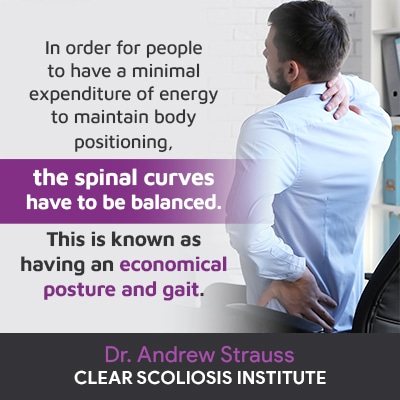

The spine has two NORMAL curvature types: kyphosis and lordosis. While kyphosis refers to an outward spinal curve occurring in the middle back, Lordosis is an inward spinal curvature occurring in the neck and lower back. A straightening of lumbar lordosis involves a loss of the spine’s natural healthy curvature in the lower back, which can lead to flatback syndrome.
To better understand how a straightening of the lumbar lordosis affects the spine, let’s first start by exploring some basic spinal anatomy and spinal-curvature types.
A healthy spine will have a soft ‘S’ shape when viewed from the sides and will appear straight when viewed from the front and back; this “S” shape is because of the spine’s natural curvature types: one that curves inward, towards the body’s center, and one that curves outward, away from the body’s center.
The spine has three main sections: cervical (neck), thoracic (middle/upper back), and lumbar (lower back); each spinal section has a corresponding curvature type.
The neck and lumbar spine feature lordotic curves that bend inward, towards the body’s center, while the thoracic curve features a kyphotic curve that bends outwards, away from the body’s center.
The health and function of the entire spine, and its biomechanics, are affected by maintaining spinal alignment, made possible by the spine’s natural and healthy curvatures.
The vertebrae (bones of the spine) are rectangular in shape and stacked on top of one another in a straight alignment and separated by intervertebral discs; if the spine loses one or more of its healthy and natural curves, it becomes misaligned, and this can be caused by a variety of spinal conditions, a straightening of lumbar lordosis included.
While this can be a touch confusing, in the medical community, the term lordosis is often used in reference to both the natural curvature type, and when that natural curvature type becomes unnatural; this is typically associated with an underlying condition such as discitis, kyphosis, osteoporosis, or spondylolisthesis.
So what does it feel like to have an excessively-straight lower back?
If a person is diagnosed with a straightening of the lumbar lordosis, this means their lower back has lost some of its natural inward curvature and become unusually straight, which can cause the development of flatback syndrome over time.
In order for people to have an economical posture and gait, meaning a minimal expenditure of energy is needed to maintain body positioning, the spinal curves have to be balanced.
If the spinal curves are balanced and the spine is aligned, a person’s gravity line naturally falls through the head, cervical spine (neck), behind the pelvis, and through the center of the hips.
That natural gravity line can only be maintained, however, if the spine’s natural curvatures remain in place and balanced; if that balance is disrupted, the body’s center of gravity shifts.
If the spine loses its natural lordosis in the lumbar spine and becomes unusually straight, it doesn’t just affect the lumbar section of the spine, but also the other curvatures because it disrupts the spine’s overall biomechanics.
See Also: Understanding Your Spine: Cervical Lordosis

While every case is different with each patient having their own unique set of experienced symptoms, some common symptoms of a straightening of lumbar lordosis and flatback syndrome include:
Again, while every case is different, related symptoms tend to increase throughout the day as the body struggles to compensate for the uneconomical posture and gait.
It’s quite common for people with flatback syndrome to flex and/or bend at the knees and hips in an effort to maintain an upright position, and this can become more taxing as the day progresses.
In addition, people can also experience neck and upper back pain as the upper back struggles to maintain alignment due to the uneven forces introduced by the loss of lumbar lordosis below.
The aforementioned symptoms can range from mild to severe, and if a condition becomes severe, the resulting flatback syndrome can make it difficult to keep up with daily tasks and responsibilities.
So now that we’ve explored some basic spinal anatomy, the different curvature types, and symptoms one can expect when there is a straightening of lumbar lordosis, what are the treatment options?
As a CLEAR-certified scoliosis chiropractor, I have experience treating a wide range of spinal conditions, lordosis and flatback syndrome included.
Through a functional and chiropractic-centered approach that integrates different treatment disciplines for the most customized and specific results, the first step on the road to treatment involves diagnosis and assessment.
As mentioned, a straightening of the lumbar spine is associated with an underlying condition, so first and foremost, the underlying cause of the loss of lordosis has to be determined and guide the design of effective treatment plans moving forward.
A comprehensive physical examination would include taking the patient’s full medical history, including whether they have had spinal surgery, or if there is a genetic predisposition to certain spinal conditions/issues.
I also observe patients’ posture and take digital photos of the patient using software to analyze posture.
Any necessary X-rays are taken. These images provide important information about the total effect of the abnormal curves on the overall spinal mechanics.

I integrate precise and gentle chiropractic remodeling/adjustments, using a variety of techniques, in an effort to realign the spine, condition-specific exercises, and in-office rehabilitation to work towards restoration of the normal spinal mechanics.
As the condition is impacted on a structural level by reducing the unnatural spinal curves and restoring as much of the healthy curves as possible, this improves the spine’s overall biomechanics, and related symptoms such as back, neck, hip, and/or leg pain can be reduced.
Any treatment effort that improves the spine’s biomechanics is proactive as it helps preserve the health and function of the spine’s individual parts, preventing increasing condition severity, and improving overall spinal health.
While relying on only one of the aforementioned treatment modalities could fall short when it comes to restoring a loss of lumbar lordosis, an integrative approach has the potential to induce a structural change, and effectively stretch and loosen the lower back’s extensor muscles, which keeps the spine as loose and flexible as possible: making it more responsive to treatment.
When the spine loses one or more of its natural and healthy curvatures, it doesn’t just disrupt spinal function in one section, but the entire spine.
So to break down the term and clearly answer the question, what is straightening of the lumbar lordosis, lumbar refers to the lower back, and a straightening of its lordosis means there is a loss of that section’s natural inward C-shaped curvature.
While the curvatures of the lumbar and cervical spine are lordotic, the thoracic spine features a kyphotic curve, meaning an outward curvature that takes on a reverse ‘C’ shape.
While there are natural and normal curvature-degree ranges, when a curvature falls beyond that normal range, by becoming over- or under-pronounced, problems can occur.
When the lumbar spine loses its lordosis and becomes unnaturally straight, over time, flatback syndrome can develop and cause a wide range of symptoms from postural changes to pain, changes to gait, and balance issues.
When it comes time to address the issue of a loss of lumbar lordosis, while there are never treatment guarantees, the key is to be proactive in determining the condition’s underlying cause.
Once the underlying cause is determined, it can guide the crafting of an effective and customized treatment plan moving forward.
Here at the CLEAR Scoliosis Institute, we assess and treat the entire spine in order to preserve its overall function and health throughout treatment and beyond.
By combining different treatment modalities such as gentle and targeted chiropractic adjustments/remodeling, condition-specific exercises, and in-office rehabilitation, I work towards restoring as much of the spine’s natural curves as possible, increasing abdominal and back-muscle strength so the spine is optimally supported, and keeping the spine and its surroundings as loose and flexible as possible.

CLEAR provides a unique and innovative way of understanding scoliosis. Sign up to receive facts and information you won’t find anywhere else.

good study
MRI of lumbosacral spine was obtain on 1.5T magnet systeam.T1,T2 and STIR sequences .Findings as lumbar curvature;-mild scoliosis of lumbar is seen with convexity towards left side & L4-L5 diffuse disc with bugle with central posterior annular tear is seen,L5-S1;-Disc desiccation with diffuse with left bulge with left foraminal foraminal disc protrusion and annular tear is seen causing bilateral lateral recess & neural foraminal narrowing with compression on bilateral
Scoliosis and degeneration are oftentimes seen together, as either one can cause the other. We will normally also see degeneration improve as scoliosis reduces and becomes stable. Our Doctors see great results with patients in these circumstances with mild scoliosis and degeneration. The degeneration of discs, tears, and narrowing do not tend to be a barrier to treatment, and modifications can be made to address these specific issues. I would advise you to contact the nearest CLEAR Scoliosis Center to you to determine if you would be a candidate for treatment. To find the nearest CLEAR Scoliosis Institute certified Doctor, please visit our website under Find a Doctor. Please let us know if we can be of further assistance. Best of luck to you.